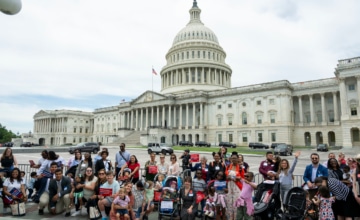FMLA guarantees eligible workers up to 12 weeks of unpaid leave a year to care for a newborn or newly adopted child, care for a seriously ill family member, or recover from their own serious health conditions. Read our post on last year’s 20th anniversary for a firsthand story on the FMLA movement.
While FMLA’s important protections have improved conditions for many families, far too many Americans still lack access to any type of family leave. In particular, workers who are low income or in poverty are less likely to have access to unpaid leave. For many of those workers, even if they do have FMLA benefits, they often cannot afford to take the unpaid time away from work. For new babies being welcomed into a family through birth or adoption, this means far less time with the most important grown-ups in their lives.
Genine, a trainer of infant caregivers in upstate New York, experienced this firsthand when her son was born. Her employer did not provide maternity leave to its employees, and Genine was able to take just four weeks of short term disability to care for her newborn son. Realizing that she could not afford to take unpaid leave, Genine returned to work when her son was just five weeks old. As an educator working directly with infants, Genine knows how important the early weeks and months of a child’s life are for bonding with his or her parents. She struggled with the necessary decision to leave her young son each day. For a few months she was able to have a relative care for her son, but when her son was seven months old Genine had to switch to a different care provider. Several years later, Genine still worries about the effect these relationship disruptions may have had on her son.
What stands out in Genine’s memory is coming home from work each evening and, especially when her son’s caregiver seemed to have difficulty coping with a crying infant, being overcome with the feeling that what he really needed was his mother. Another consequence: Because she returned to work after only five weeks, Genine was not able to breastfeed her son for nearly as long as she was hoping to; she and her son had just finally mastered the techniques and settled into a routine when it was time for her to return to work.
In the United States, 62% of mothers with infants are in the workforce. Genine’s story is hardly unique, and her feelings echo the sentiments of many mothers across the country who do not have access to paid leave and so must return to the workforce during the momentous early months of their rapidly developing newborn’s life. As Genine emphasized, “If I had been able to stay home with my son for one year, or six months, or even three months, it would have made a big difference.”
There is hope for all the new moms, dads, and families who need time to care for others. The momentum from the anniversary of FMLA has continued toward the next step of ensuring that all workers have access to paid family leave insurance. Quite simply, such leave would allow workers to receive a portion of their pay when it is necessary to take time away from their jobs for specific family or medical needs.
Last year, Sen. Kirsten Gillibrand (D-NY) and Rep. Rosa DeLauro (D-CT) introduced federal legislation, the Family And Medical Insurance Leave Act (the FAMILY Act), that would provide eligible employees with up to 12 weeks of paid leave for their own serious illness; the serious illness of a child, parent, or spouse (including a domestic partner); the birth or adoption of a child; the injury of a family member who is in the military; or exigencies arising from a service member’s deployment.
The FAMILY Act builds on successful state family and medical leave insurance programs. Family leave insurance has existed in California since 2004 and in New Jersey since 2009; earlier this year Rhode Island became the third state to implement legislation putting into place paid family leave. Analyses of California’s law show that both employers and employees have benefited from the program. In New Jersey, the program costs are even lower than expected.
A national paid family leave policy would provide job security and consistent income during a time when it is essential for parents to bond with a new child or care for an ill family member. There is evidence that such leave policies not only help promote parent–child attachment and improve child health but also improve the economic conditions of families.
As Genine acknowledged, family leave at heart is about building a relationship that would help set her baby’s course for a lifetime. A baby’s early relationships, especially with parents, shape the architecture of the developing brain as well as their ability to form trusting relationships later on in life. These relationships require a depth of love for and knowledge of a child that a primary caregiver comes to possess through care, consistency, and, above all, time.
- A period of paid leave after birth contributes to the healthy development of infants and toddlers.
- Time at home with newborns, infants, and toddlers gives parents the time they need to breastfeed, attend well-child medical visits, and ensure that their children receive all necessary immunizations.
- While more than three quarters of women initiate breastfeeding, only 36% continue through six months of age. Studies find that returning to work is a leading impediment to continuing nursing.
- Family and medical leave improves outcomes for the entire family, including parents and caregivers.
- Longer leave periods are associated with benefits for the mother as well as the baby, including declines in depressive symptoms, a reduction in the likelihood of severe depression, and improvement in overall health.
- Paid leave policies can benefit employers, taxpayers, and the economy, now and in the future.
- Positive, consistent relationships during a baby’s early years yield confident individuals who are better equipped for success in school and in life, paving the way for a higher quality workforce and strong economic growth.
What can you do?
- For more facts on paid family leave, click here.
- To get involved in the movement, join the FAMILY Act tweet storm on Wednesday, February 5th from 3:00-4:00 pm ET. You can follow along or contribute to the conversation using the hashtags #FMLA21, #FAMILYAct and #paidleave.
- Share your story! Send a tweet to your legislators and let them know about the importance of paid family leave and the FAMILY Act.
References:
U.S. Census Bureau, “Women 16 to 50 Years Who Had a Birth in the Past 12 Months by Marital Status and Labor Force Status: Table B13012.” In 2012 American Community Survey. U.S. Census Bureau, 2013. www.census.gov
U.S. Department of Health and Human Services, Surgeon General’s Call to Action to Support Breastfeeding. Washington, DC: U.S. Department of Health and Human Services, Office of the Surgeon General, 2011, www.surgeongeneral.gov
Eileen Applebaum and Ruth Milkman. Leaves that Pay: Employer and Worker Experiences with Paid Family Leave in California, January 2011. www.cepr.net
Vicky Lovell, Women and Paid Sick Days: Crucial for Family Well-Being. Institute for Women’s Policy Research, January 2007. www.iwpr.org
Pinka Chatterji and Sara Markowitz, Family Leave After Childbirth and the Health of New Mothers. National Bureau of Economic Research, 2008. www.nber.org
National Research Council and Institute of Medicine, From Neurons to Neighborhood: The Science of Early Childhood Development. Jack Shonkoff and Deborah A. Phillips, eds. Washington, DC: National Academy Press, 2000.





